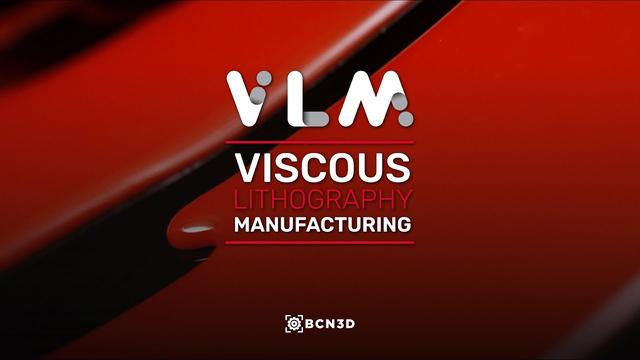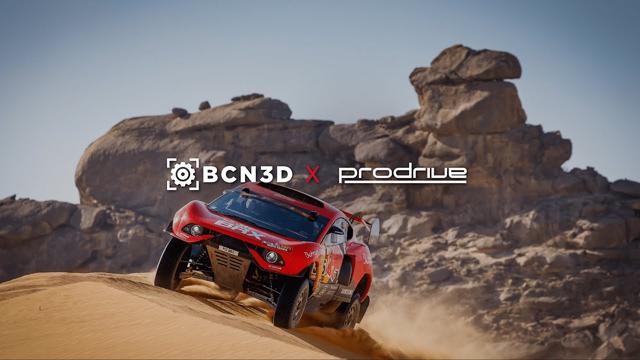
Barcelona-based BCN3D announced a new 3D printing technology to advance alongside its FFF solutions. Described as a “breakthrough 3D printing technology,” the patented Viscous Lithography Manufacturing (VLM) process laminates thin layers of high viscosity resins onto a transparent transfer film, where a light source solidifies each layer of material, resulting in high-performance parts.
To leverage this technology, BCN3D partnered with French chemicals company Arkema to co-develop new resins that capitalize on the singularities of VLM. Aiming to create a more affordable 3D printing solution to compete with prohibitively expensive polymer printers that require costly hardware, BCN3D’s combination of VLM and new materials will appeal to small and medium-sized businesses.
After three years immersed in developing the VLM process, BCN3D co-founder and CEO Xavier Faneca described it as the “future of manufacturing.”The engineer also accentuated that the technology can lead to local production, customization, control of supply chains, and sustainability, which are essential for companies investing in 3D printing technologies. Faneca hopes that VLM will drive the adoption of 3D printing and help the technology become a pivotal point of manufacturing.
Image courtesy of BCN3D.
What distinguishes VLM from other resin technologies on the market is its ability to process resins fifty times more viscous than the industry standard, yielding an endless range of applications.
These extremely viscous resins are “perfectly laminated into thin layers of materials on the top of the transparent transfer film in a mild and safe fashion, avoiding the drawbacks from heating strategies,” explained BCN3D’s Head of Materials Dario Destro during the VLM launching event.

Additionally, the Spanish company made sure VLM’s mechanical system allowed the resin to be laminated from both sides of the film, making it possible to implement strategies to speed up printing times or even combine different resins to get multi-material parts and easy to remove support structures. BCN3D chose a 3D printing lamination process to avoid the drawbacks of conventional resin 3D printers that use tanks or vats (such as digital light processing).
The process starts when a roller picks up the resin, which is laminated to the underside of a transparent film. Then the film is transferred to the printing area, where the build plate rises to come into contact with the resin. Next, the UV light engine cures the resin solely in the specified area, creating the new layer of the product being printed. Once the build plate retreats and the cured layer is peeled away from the film, the unused resin is recovered and recirculated back into the reservoir. The process is repeated until the job is complete. Since it is designed to filter and recirculate resin, making sure every drop eventually becomes a printed part, it is a sustainable, zero-waste technology.
Using a light source consisting of UV light and an LCD screen, VLM delivers a constant time per layer, regardless of whether it prints one or 100 parts at once. Furthermore, since it is not limited by the vat dimension, a complex temperature, or tricky components, BCN3D explains that all that’s needed to scale up is a bigger LCD screen.
Furthermore, the company stated that without a strict low viscosity constraint, chemical companies obtain the freedom to formulate, as a whole new set of ingredients and modifiers can be added in the resin to achieve the desired effect on thermal and mechanical properties.
“VLM processes resins that obtain 3x the amount of impact resistance for rigid materials and a 200% increment in tear strength compared to industry-standard formulations,” revealed BCN3D.
Current testers of this new technology include tier one automotive manufacturer Saint Gobain and UK motorsport company Prodrive. As one of the first companies to use VLM, Prodrive has been assembling end-use parts made with VLM mounted directly on cross-country cars. Prodrive is already using BCN3D’s FFF machines on-site for its cars (which compete in the Dakar rally and Le Mans race)
“VLM technology seems to combine all the best features of the different additive manufacturing technologies, and even offer some unique advantages. Right away, we knew that we wanted to get involved in the VLM technology adoption program from BCN3D and try to make some of our existing FFF parts with the VLM. For Prodrive, materials are the key to making durable end-use parts,” explained Callum Harper, Design Engineer at Prodrive. “VLM allows us to continue to use the engineering materials that we know and love, but instead in significantly finer resolution in all three directions, and the material is much more homogeneous, making the finished parts behave much more like a traditional injection molded part. Additionally, via the VLM process, a bed full of parts can be printed in the same time it takes to make a single part in FFF machines.”
Developed to specifically address BCN3D’s vision of unlocking manufacturing autonomy, VLM is expected to offer companies the tools to design and manufacture their own products, having full control over the AM fabrication life-cycle. To discover the new VLM technology and see its full potential, innovators from companies, universities, technology centers, and service bureaus are encouraged to apply to BCN3D’s VLM Technology Adoption Program, where they will witness how AM applications engineers introduce users and help them develop custom analysis and solutions with VLM within your company. Partakers will join Saint Gobain and Prodrive in being the first to discover the new VLM and experience its full potential for themselves with real 3D printed parts and individual attention on their exact printing needs.
Stay up-to-date on all the latest news from the 3D printing industry and recieve information and offers from thrid party vendors.
Tagged with: Arkema • BCN3D 3D printer • BCN3D Technologies • BCN3D VLM • resin 3d printing • spain • UV light • Viscous Lithography Manufacturing • viscous resins • VLMPlease enable JavaScript to view the comments powered by Disqus.